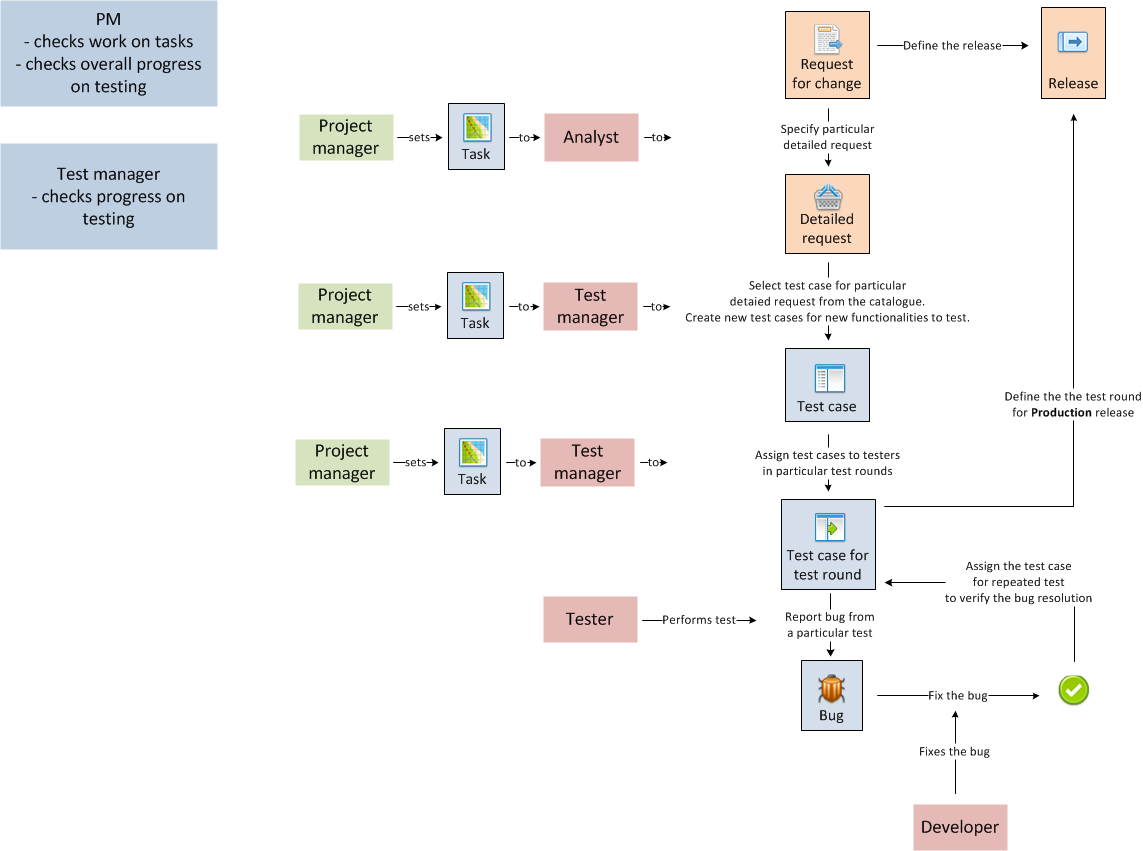Test management
Testing process is performed according to ITIL v3 in step Coordinate implementation of the Change management process. There is process of Release management following further in this step. Same like other processes also testing needs to be tailored to the company size, its values and risk appetite.
ObjectGears provides following process meeting ITIL requirements and representing an effective test management.
Two roles play a key role in this process:
- Project manager - sets tasks and checks work progress:
- Sets task to Analyst to break up Change request to Detail requirements, that are well manageable from the perspective of development and following testing.
- Sets task to Test manager to choose those test cases from the catalogue, that verify meeting requirements, and define new test cases, that enable testing newly deloped functionalities.
- Sets to Test manager to assign test cases in particular test rounds to particular Testers.
- Test manager - based on task from the project manager:
- Identifies relevant test cases, creates new necessary cases and introduces them into the test case catalogue.
- Assigns test cases to Testers.
Testers perform test assigned to them acording to the definitions of test cases and report bugs. Developers work bugs assigned to them for correction. After that developer indicates that the bug is corrected, there is a request automatically created for testing the test case, at which testing the bug was originally reported, and it is assigned to the tester, that reported the bug.
Since change requests are broken up to detailed requests, to which test cases are assigned, Project manager can easily monitor testing progress and status of solving the reported bugs in relation to particular developed functionalities. This enables him to assess well readiness for the final UAT tests or release into production.

Besides Test cases ObjectGears works with Test scenarios. Test scenario is a generic description of a test case. It may be broken up into steps that the tester shall perform. Test case is a concrete specification of a test scenario. Particular test cases have a common scenario and vary in data with which tester works.
Examples of screens
Test scenario
Test scenario contains code, name, test description, applications that it relates to, prerequisites for performing the test and expected result. It is possible to attach also files with other details to the test scenario. In the bottom part of the screen there are particular steps of the test and overview of test cases, in which the test scenario is used.
Test case
Test case represents a particular test scenario with particular data that the tester will use at the test, because various data (e.g. product type, customer type or sales point type) may result in various test results. Test cases may be defined already in the phase of breakdown of change requests (RFC) in particular detailed requests, for which the test cases verify their fulfilment. In the bottom part of the screen we can also see in which test rounds the test case is used.
Test round
Within change request (RFC) realization we perform testing in particular test rounds. Key attributes of a test round is name, code, change request (RFC), to which it relates, and status. In the bottom part of the screen we can see overview of open test cases that have to be still performed and overview of all the test cases assigned within a test round.
Test case for test round
Test case for test round is a task given to a particular tester to perform a particular test case in a given time. If there was a defect reported in the past, the test case for test round can refer to such defect, if it shall verify correctnes of the bug resolution. Tester can report the bug that he/she identified during test case by clicking on button REPORT DEFECT. In the bottom part of the screen there is an overview of defects that were reported from the test case for test round including their status and person to which they were assigned for solving.
Defect
Key attributes of defect are name, code, test case for test round, from which the defect was reported, status, who reported the defect and who is solving it. User can also attached a file (e.g. screen with error message). If also external subjects participate on defect solving, it is possible to use property Group, that enables to display to external subjects only those defects that are relevant for them.